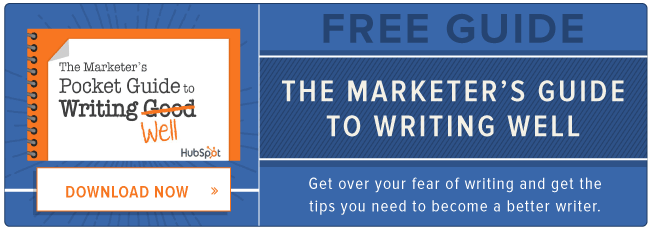
I’ve done a lot of dumb things as a writer. But that’s okay. Mistakes are the best way to learn, right?
When we make a mistake once, we usually don’t make it again. And the less time we have to spend correcting our mistakes, the more time we have to actually get things done.
I’ve outlined a list of eight common mistakes that professional content writers sometimes make below. The idea is that once you learn about these mistakes, you’ll be less likely to commit them yourself. Let’s walk through them …
8 Mistakes Even Professional Content Writers Make (And How to Avoid Them)
Mistake #1: Thinking that you can’t break through writer’s block.
Some people tend to think that writer’s block is an unbreakable force — nothing can be written until the block is broken.
The truth is, you can break writer’s block. Some people stand on their head, but there are other helpful tools you can use, too.
Next time you experience writer’s block, try shifting your mindset. Don’t think, “Oh no! I can’t write.” Instead, think, “Okay, I’ve got this. I’m going to make it.”
Want more advice on how to beat writer’s block and actually enjoy writing again? Check out this post.
Mistake #2: Not editing your work.
You need time to edit your writing when it’s cold. In other words, let some time pass before you go back and work on that article again. You’ll view it with a new sense of curiosity, perspective, and insight.
Not everyone loves editing. I get that. Look at it this way, though: Editing turns something great into something even greater. That’s something to look forward to. For advice on how to approach a piece of content, check out these strategic editing tips from HubSpot’s Ginny Soskey.
Mistake #3: Not proofreading your work.
After you edit, you need to proofread, too. Editing is making those big changes to the content itself. Proofreading is making the tiny changes to the grammar and spelling.
I’ve made a habit of never releasing a word of content until it’s been edited or proofread at least four times. Proofread, and proofread again. You’ll be glad you did.
Before you publish your next piece of content, check out this helpful proofreading checklist.
Mistake #4: Not doing any research.
You may be the world’s most brilliant writer and master of your subject, but you should do a little bit of research on your subject matter. People aren’t as impressed by your opinion as they are by a breadth of studies, data, evidence, and other information that corroborate your opinion.
Get ready for hard work, though. Here’s how one researcher described the research process:
Research is not only a science but also an art and it is not easy. It requires honest and hard work with patience and perseverance. Not everyone is a born writer and authors can fall ill with headaches and backaches during the process of writing the research results.”
Research can be fun. When you realize that you’re providing your readers with insight and advanced knowledge, a simple writing project can take on a new level of excitement. Need help uncovering credible statistics to support your content, check out these nine reputable resources.
Mistake #5: Not defining your pronouns.
Huh? What does “not defining your pronouns” mean? Allow me to explain …
The following words are pronouns:
- It
- This
- These
- Those
- That
There are a lot of pronouns in the English language. Pronouns are helpful, useful, important parts of speech.
What is the problem? Not defining them:
- Those are bad. What are bad?
- That’s no good. What’s no good?
- It’s a problem. What’s a problem?
- Destroy these. Destroy what?
You should define all pronouns either within the context of your writing or within the sentence. Undefined pronouns lead to unclear writing.
Mistake #6: Writing too fast or too slow.
There’s no correct writing speed. Each writer should write at the pace that suits them and allows their creativity to flow. However, be aware that your speed of writing influences your quality of writing.
- If you write too fast, you could make sloppy mistakes.
- If you write too slowly, you could make clumsy mistakes.
When reading, the mind goes over information faster than while writing. Keep this in mind when you write. Your mind easily processes long sentences or big words when you’re writing them. But to the reader — whose eyes are skimming across your content at 300 words per minute — your writing is dull, ponderous, slow, and agonizing.
If you write fast, your brain is moving at a closer equivalent to the normal reading speed. Of course, you should still pay attention to your words, sentences, and structure. But at the same time, you’ll be able to get down those thoughts in a more fluid and natural way.
Here’s how the The Huffington Post reported on one writing speed researcher:
Typing can be too fluent or too fast, and can actually impair the writing process,” Srdan Medimorec, a PhD candidate in the Faculty of Arts at Waterloo said in a statement. “It seems that what we write is a product of the interactions between our thoughts and the tools we use to express them.”
A 2016 study from the University of Waterloo discovered, “the quality of your writing will likely get better if you simply type slower.”
Does this mean that you should try to move your fingers slowly, type with one hand, or just trudge along at a lazy pace? Not necessarily.
Each person has their own right pace. And different types of content demand a slower or faster pace. You move at the pace that’s best for you.
In some situations, the ideas and words are coming at an incredibly fast rate. You have to type as fast as you can. In other cases, you might be doing careful research, searching for the precise word, or writing about a sensitive subject. Slowing down is a good idea.
Mistake #7: Not understanding who your readers are.
If you want to become a better writer, become a better student of your reader. It’s actually pretty simple.
Great writing is connecting with readers in a meaningful way. You won’t be able to perform that task unless you get in their heads. I challenge all writers, before putting a single word on a page, to do as much research and gain as much understanding of their potential readers as possible.
The process is as simple as going through the exercise of creating a persona, and reminding yourself of that person every time you write. (Check out this free tool to get started.)
Mistake #8: Not outlining an article before you write it.
Outlining might bring back memories of high school English class. Don’t worry. That’s not what I’m talking about here.
The process of outlining is simply creating a structure for your article.
I do a lot of writing, and one of the things that helps me write with clarity and speed is outlining. First, I jot down a quick introduction and conclusion. This helps me to lead up to my subject matter, and then sum it up. Doing so also makes me fill the empty space between with something relevant and meaningful.
Generally, my outline simply looks like a few bullet points. My goal is to write down the main things I want to talk about. Usually, they aren’t even complete sentences. (No big deal. I’m not writing my article at this point. I’m just outlining it.)
The whole process takes me ten minutes or so, but it saves me hours of time. Plus, it gives my article more clarity.
Ready to Write?
Writing better is about blowing apart old habits and horrible mistakes. Even though I’ve been writing almost every day for ten years, I still make mistakes. Hopefully, my mistakes are becoming fewer and fewer, but I still catch myself making them sometimes.
At the same time, however, I feel like I’m improving. And that’s what becoming a better writer is all about.
What about you? What mistakes are you eliminating in order to improve your writing?


